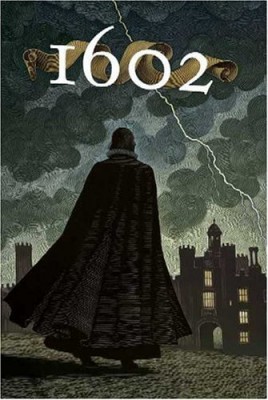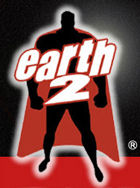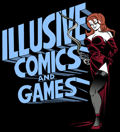| 1602
I try
never to believe the hype, especially in the realm of comic
books and especially from Marvel Comics.
I’m
not saying that Marvel is not deserving of its spot among
the Big Two, since there is a bevy of great storytelling
going on at that company and equally astonishing artwork
(just nowhere near Chuck Austen), but Marvel has a tendency
to over-hype their “comic events.” An example
would be Trouble from Mark Millar and Terry Doddson;
Marvel lauded it as a romantic comedy that was meant to
explain better the origins of Spider-Man’s parents,
or something to that effect. It ended up being absolute
drivel with little connection to the Spider-Man mythos,
made almost readable by the breast-tastic art from Doddson.
I did not buy the series, reading a few issues my friend
had purchased, and thankful that my usual brand of exclusionary
skepticism had finally paid off.
But
it doesn’t end there: Who could forget the debacle
made of the relaunch of Epic, proclaimed to be Marvel’s
attempt to finally give young comic writers and artists
a chance, and turning out to be an impractical and poorly
handled attempt to make slaves of intellectual property.
The MAX line of comics would be another much hyped but less
loved Marvel venture; the only book that I can think of
that even springs from the adult-oriented line that garnered
some recognition is Alias, and that’s really
more about Bendis’ writing than anything else that
made the book popular. Does anyone remember War Machine
fondly? Howard the Duck? I thought not.
The
hype is usually never worth believing, so when news trickled
down that Neil Gaiman was going to write for Marvel, I wasn’t
unimpressed, but rather scared. Gaiman is one of the great
writers of our age of funny books, not to mention a damn
fine novelist in his own right, and working for Marvel seemed
a likely black mark to put on his record should the project
fail. That project was 1602.
Imagine
if the Marvel Universe had happened nearly four hundred
years ago. Imagine a world where toxic chemicals did not
blind Mathew Murdock, but, still blind and somehow special,
he is no less the daring devil he ever was. Imagine a world
where Queen Elizabeth still rules, aided by her court doctor
Stephen Strange, and her master of spies Sir Nicholas Fury.
Imagine an Inquisition that is both burning witches and
“witchbreed,” the “devil-spawned”
individuals that display extraordinary abilities and powers.
Imagine a New World, not even a country yet, but still protected
by an American sentinel. Now imagine these characters and
more thrown into a vicious web of assassinations, monarchial
power plays, and world-ending catastrophe if the cause for
the chaos ensuing in the 17th century is not discovered.
It’s
a rather good book, but it isn’t a great book. It’s
intricately plotted and Gaiman takes the time to, not only
transplant the names of his characters from the modern time
period to this early version, but also their personality.
Nicholas Fury is a cigar-smoking bastard, only he has no
cigar and despite his penchant for straightforward speech,
his character has been a noble too long to speak without
some intelligence. Angel is not a spoiled rich boy in 1602,
but there is an air of haughtiness that surrounds his character.
Murdock is brash and flippant, no matter what clothes or
era he might be wearing.
Maybe
the problem is that Gaiman does so good of a job transplanting
the characters that the reader ends up bored, because we
already know these characters inside and out. Is Carlos
Javier going to be a rational, kind man who believes all
disparate people can get along? Yes he will, and he might
just gather around him a group of young witchbreed and train
them to help him in that respect. Oh look, is Count Otto
Von Doom going to be a despotic maniac with a past tied
to a certain ship with four voyagers on it? You bet your
graphic novel collection he does.
I will
admit that two things threw me for small loops and I did
not expect them. One being the “package” being
delivered from Jerusalem and what it truly was, and there
was the ultimate cause of all of 1602, which while interesting
(and I will not spoil it for the fanpersons) seemed somewhat
tacked on. What really intrigues me, and what story I would
like to be told, since Gaiman has a contract for at least
one more project for Marvel, is what happens after the events
of 1602, and what it means for the development of America
and the world at large.
The
artwork is another aspect of the work that I am a little
torn on. Andy Kubert is talented without doubt, and his
character design is always top notch. Kubert goes above
and beyond in crafting Victorian garb to match the characters,
not necessarily to recreate the costume of the modern era,
but to convey the idea of the character. Fury’s outfit
consisted of what could be leather armor, and still looked
clothing-like, balancing his role as member of royal court
with his cloak and dagger profession. Strange has robes,
but no gaudy capes, yet somehow carries an air of mysticism
and Murdock, looking far less the sleek daredevil than he
is a vagabond in loose fitting clothing, somehow feels no
less dangerous.
All
of this is helped by the excellent coloring by Richard Isanove,
Isanove employing his digital painting technique last seen
in Origin (another over-hyped Marvel project). While I do
prefer colorists to do coloring in the old fashioned way,
the computer allows Isanove to reach an incredible level
of detail that is need for the book. Also of note are the
scratchboard illustrations for every cover of the eight
issue series that form chapter breaks, as well as the cover
to the collection, all done by Scott McKowen.
I didn’t
believe the hype on 1602, figuring I’d wait
for the trade to come out. I grabbed the hardcover version
on a whim, and twenty-five dollars for all eight issues,
an introduction by Publisher’s Weekly reviewer Peter
Sanderson, an afterword by Gaiman himself, as well as the
script to the first issue, and two artist process sections
from Kubert and McKowen, is not bad. You pay more but you
get more. Is it worth a pick-up? If you like the concept
of “What If?” (which I do) and want to read
the most intricately plotted version of one you are likely
to find, then go forth and spend cash fanpeople.
For
those looking for a surprise or two, or simply expect everything
Gaiman writes to be groundbreaking, this isn’t for
you. I leave it to your discretion, readers.
Marvel
1602
|






